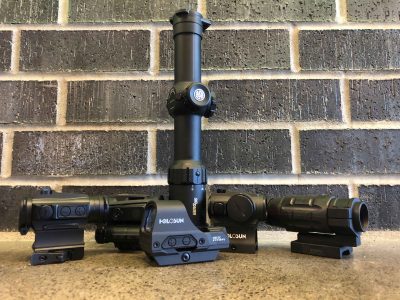The point of this article is to guide the end user to the optic set up on an AR15 that best suits their needs. Coming from the guys behind the counter we will sell you anything, however, is the optic the customer wants practical for their needs?
Bottom line up front, the average user needs a simple red dot for any style AR15.
The optic set ups we will be talking about are:
- Iron sights.
- Absolute co-witness red dot.
- High mounted red dot.
- High mounted EoTech.
- High mounted red dot with flip up magnifier.
- Fixed Magnified optic.
- Fixed magnified optic with top mounted red dot.
- Low power variable optic (LPVO)
- LPVO with 45 degree offset red dot.
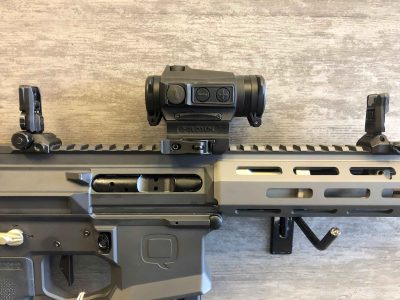
We are blowing past iron sights for these reasons: avid shooters will buy iron sights but rarely train with them; middle to low tier rifles don’t always come with iron sights out of the box; low lighting at indoor gun ranges make it difficult to get a good sight picture. Iron sights are classic and never fail, however, with modern optics they are becoming a lost art.
Moving to red dots, in the photo above is a red dot mounted at an absolute co-witness height with iron sights. Reasoning a shooter would want an absolute or lower one-third co-witness is to be able to see their iron sights through the red dot glass. In case your red dot is damaged or runs out of battery the iron sights are there as a back up.
The best option for a new shooter buying their first AR15 is to get a red dot without iron sights. Red dots are great for a shooter who goes to indoor ranges or goes to an outdoor range that doesn’t exceed 200 yards. Red dots give you peak performance for close ranges and speed. Red dots allow you to easily shoot with both eyes open and to focus on the target while still aiming with the dot. Lastly, red dots are great for any caliber with any length barrel.
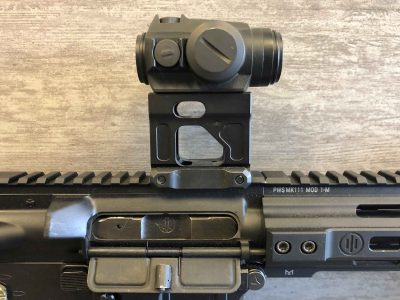
Red dot on a high mount is more comfortable to shoot and allows the shooter to have a more heads up stance but there becomes a hold over issue. The hold over is called ‘height over bore’ and that is the distance between the center of bore to the center of the optic. Depending on the distance the red dot is zeroed the shooter must hold the dot above the spot they want the bullet to land. High mounts require additional training to understand how the trajectory of your bullet is impacted. Down side to high mounts is that the shooter loses their chance to see their iron sights through the red dot glass; meaning the shooter would have to remove the optic to use their back up iron sights. Nice part about mount in the photo above is that it comes with a rear iron sight inside of the mount. Same as what was mentioned before, these high mounted red dots are great for any caliber and barrel length.
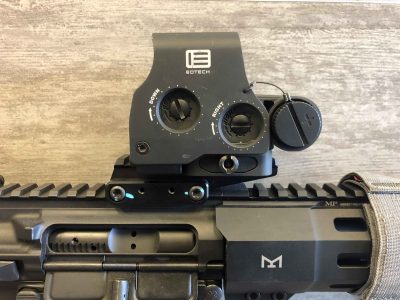
EoTech gets a honorable mention because it is practically a sin to not mention it when talking about optics. EoTechs are a lot like a red dot but have a circle and a ring instead of only a dot. The dot and ring isn’t for aesthetic but is used as a bullet drop compensator (BDC). If the shooter zeros the dot at 50 yards the bottom of the circle is equal to 25 feet; this helps with the before mention height over bore issue. EoTech optics provide more window space to look through than a normal red dot, however, the EoTech EXPS and XPS line of optics chew through batteries very fast; Eotech claims to have 1,000 continuous hours of battery life while most other red dots offer 50,000 hours. Also, EoTechs have a holographic emitter which is much different but to the average shooter this doesn’t matter.
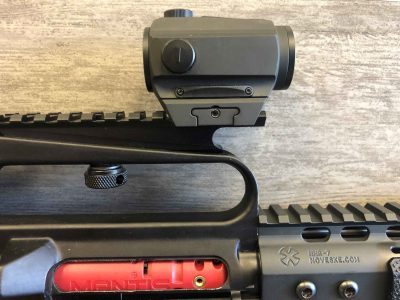
This red dot mount is in here just for fun! This red dot is mounted on top of an A2 style upper receiver. The original Armalite prototype rifles all the way to the M16A2 used a fixed carry handle upper. Troops and civilians would use a bolt-on picatinny rail to attach red dots to the top of the carry handle.
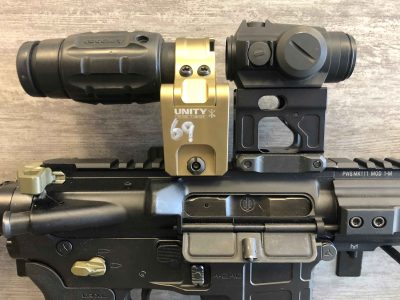
Lets talk magnification! Red dots have the limitation to see far away. Easy fix, get a magnifier. The perk of magnifiers are that they allow the shooter to get more distance out of a red dot; 200 yards becomes easier and it allows the shooter to stretch the distances that they would usually not shoot. The down side to magnifiers are that they add weight, take up room on the rifle, and have some sort of eye relief to use the magnifier. Also, most magnifiers shooters get are only three power. In my opinion that is a little weak because a lot of fixed power optics start at four power. Magnifiers look cool and can be useful however, why not just do a fixed power optic?
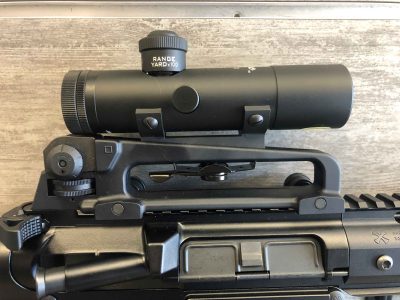
Pardon the old school optic but the point is the same. This is a Brownell’s Retro clone of what guys used to run. It is a fixed four power optic without a BDC. Trijicon ACOGs have a varied of BDCs to match calibers and barrel lengths for the shooter to match the optic to their gun. The power of using a fixed power are that it allows a shooter to see further and in turn shoot further with better accuracy and precision. Fixed powered optics potentially allow a shooter to reach ranges of 400 to 500 yards. The down side is that shooters suffer at distances closer than 25 yards and the speed of moving from target to target. Finally, fixed powered optics like the ACOG have to be removed from the rifle if the shooter wants to access their iron sights, the Brownells Retro clone is an exception to this.
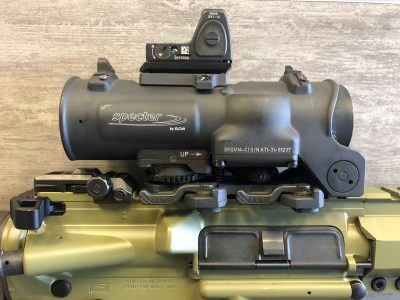
This Specter-DR by ELCAN also won’t let the shooter use the back up iron sights. If shooters are worried about running fixed powered optics at closer ranges then the simple solution is to mount a red dot on top or at the 45 degree position. This combination can allow the shooter to engage targets at closer distances with the red dot or take accurate shots with the fixed powered optic. Engagement distances vary from 25 to 500 yards between the two optics.
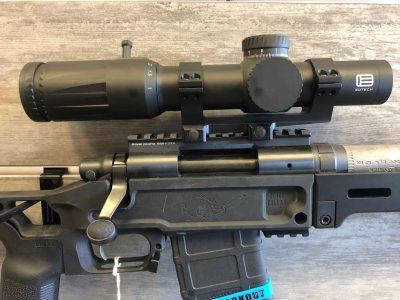
Upping the power factor! Low power variable optics (LPVO) are the next step up to allow a shooter get further out. LPVOs come in 1-6, 1-8, or 1-10 powers. The one power lets the shooter use it like a red dot while the highest power allows them to take longer shots. All LPVOs come with some sort of BDC reticle in minutes of angle (MOA) or milliradians (MRAD). These units of measurements let the shooter track the shot when it impacts or do holdovers before they take a shot. LPVOs can be used with any barrel length or caliber (unless otherwise bought with a specified BDC from the manufacturer). The downside to the LPVO are that they have a picky eye relief and transitioning from low power to high power or vise versa. What if the shooter needs to make fast transitions?

Slap a red dot on it! Just like the fixed power optic. Instead of cranking the power down a shooter can make a fast transition to the red dot to make a quick shot. The photo above is with a 45 degree offset which is what many competition shooters use. Best of all worlds, disregarding the weight and space it takes on a rifle.
In summary, a simple red dot is what most new or average shooters should invest in. Shooters should get an LPVO if the goal is to shoot at a target further than 300 yards away. This leaves flip-up magnifiers and and fixed power optics to pick up the slack in the middle. Shooters should also know the realistic capabilities of their weapon system; so putting a 1-10 powered LPVO on an eight inch 9mm weapon is not a good idea.

